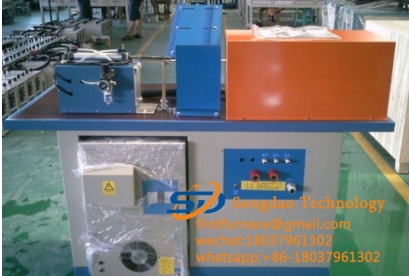- 12
- Apr
Analysis and Selection of Power Adjustment Scheme for Induction Heating Furnace
Analysis and Selection of Power Adjustment Scheme for Induction Heating Furnace

Since during the induction heating process, the load equivalent parameters will change with the temperature and the melting of the charge and the heating process needs, the induction heating power supply should be able to adjust the power of the load. Since series resonant inverters have many different power adjustment methods, we need to make reasonable choices in the development process according to actual applications and performance requirements.
The power adjustment methods of the system can be generally divided into two types: DC side power adjustment and inverter side power adjustment.
The DC side power regulation is to adjust the output power of the inverter by adjusting the amplitude of the input voltage of the inverter link on the DC power side of the inverter, that is, the voltage regulation power regulation mode (PAM). In this way, the load can be operated at resonance or a working frequency close to resonance through phase-locking measures.
There are two ways to adjust the output voltage of the induction heating furnace: phase-controlled rectification or uncontrolled rectification followed by chopping.
Inverter side power regulation is to change the output working state of the inverter by controlling the switching characteristics of the power devices of the inverter link in the inverter measurement, so as to realize the regulation of the output power of the inverter.
The inverter side power modulation can be divided into pulse frequency modulation (PFM), pulse density modulation (PDM), and pulse phase shift modulation. When the inverter side power adjustment scheme is adopted, uncontrolled rectification can be used on the DC side, which simplifies the rectifier induction heating furnace and improves the overall grid-side power factor. At the same time, the response speed of the inverter side power adjustment is faster than that of the DC side.
The phase-controlled rectification and power adjustment induction heating furnace is simple and mature, and the control is convenient; the efficiency and reliability of the power supply of the chopper power adjustment will be reduced in high-power situations, and it is not suitable for the normal operation of the power supply. Pulse frequency modulation will have a great influence on the heating workpiece due to the change of frequency during the power adjustment process; pulse density modulation has poor working stability in power closed loop occasions, and presents a stepped power adjustment method; pulse phase shift power adjustment will Increasing power loss, such as the use of soft switches, will increase the complexity of the induction heating furnace.
Combining the advantages and disadvantages of these five power adjustment methods, combined with the work of this subject in high-power situations, choose to use thyristor phase-controlled rectification for power adjustment, and obtain the variable DC output voltage supply inverter link by adjusting the thyristor conduction angle. Thereby changing the output power of the inverter link. This kind of power adjustment method of induction heating furnace is simple and mature, and the control is convenient.
